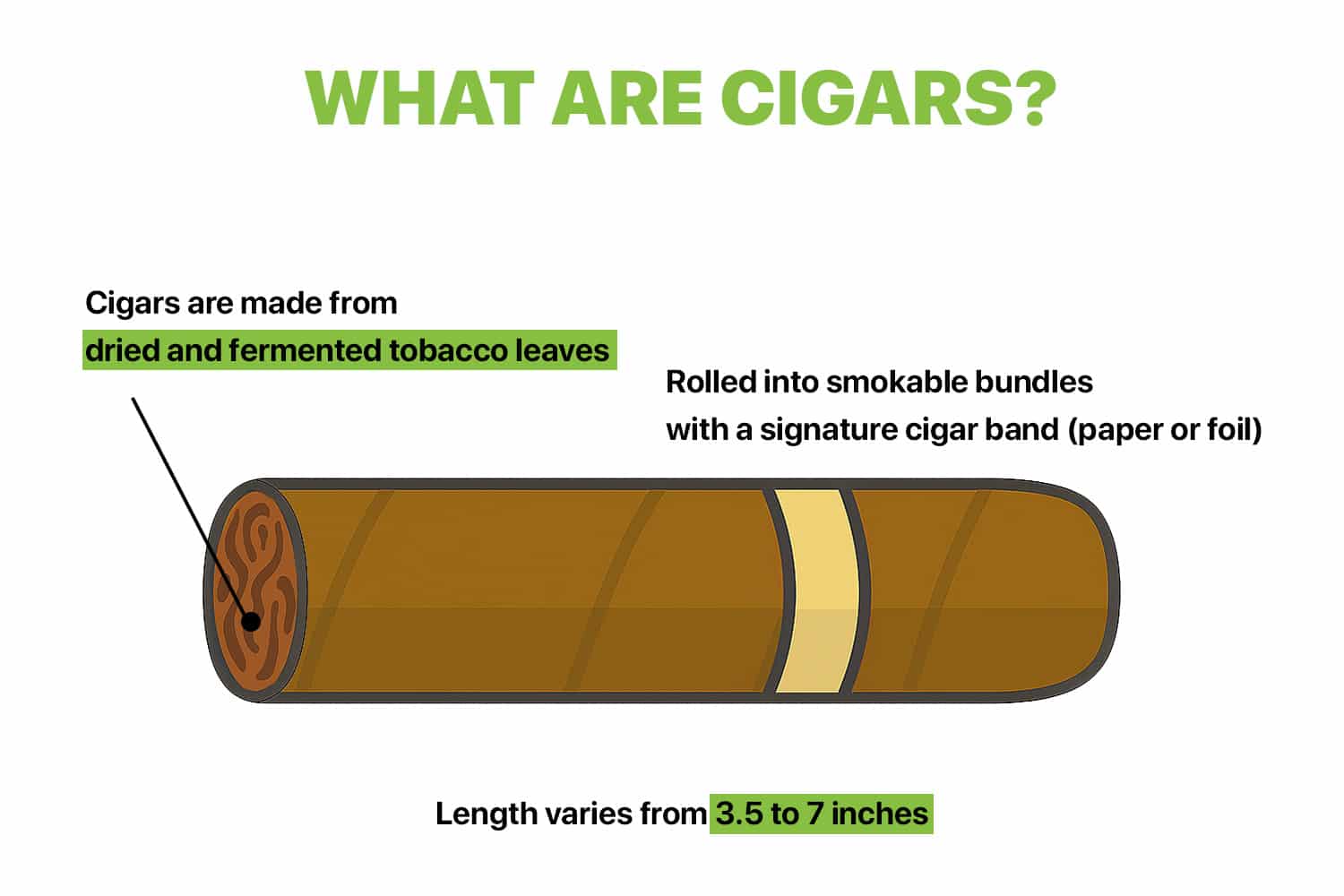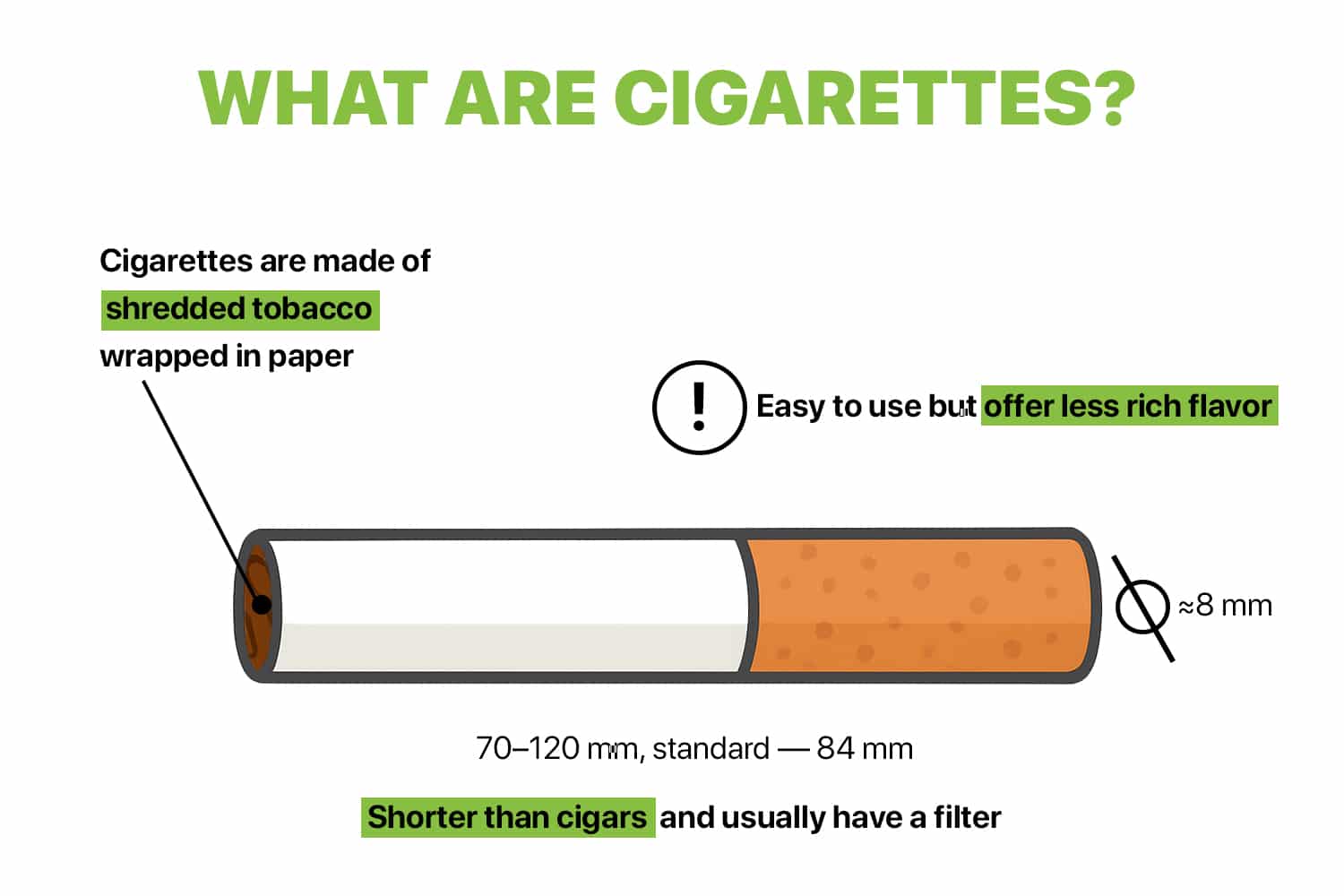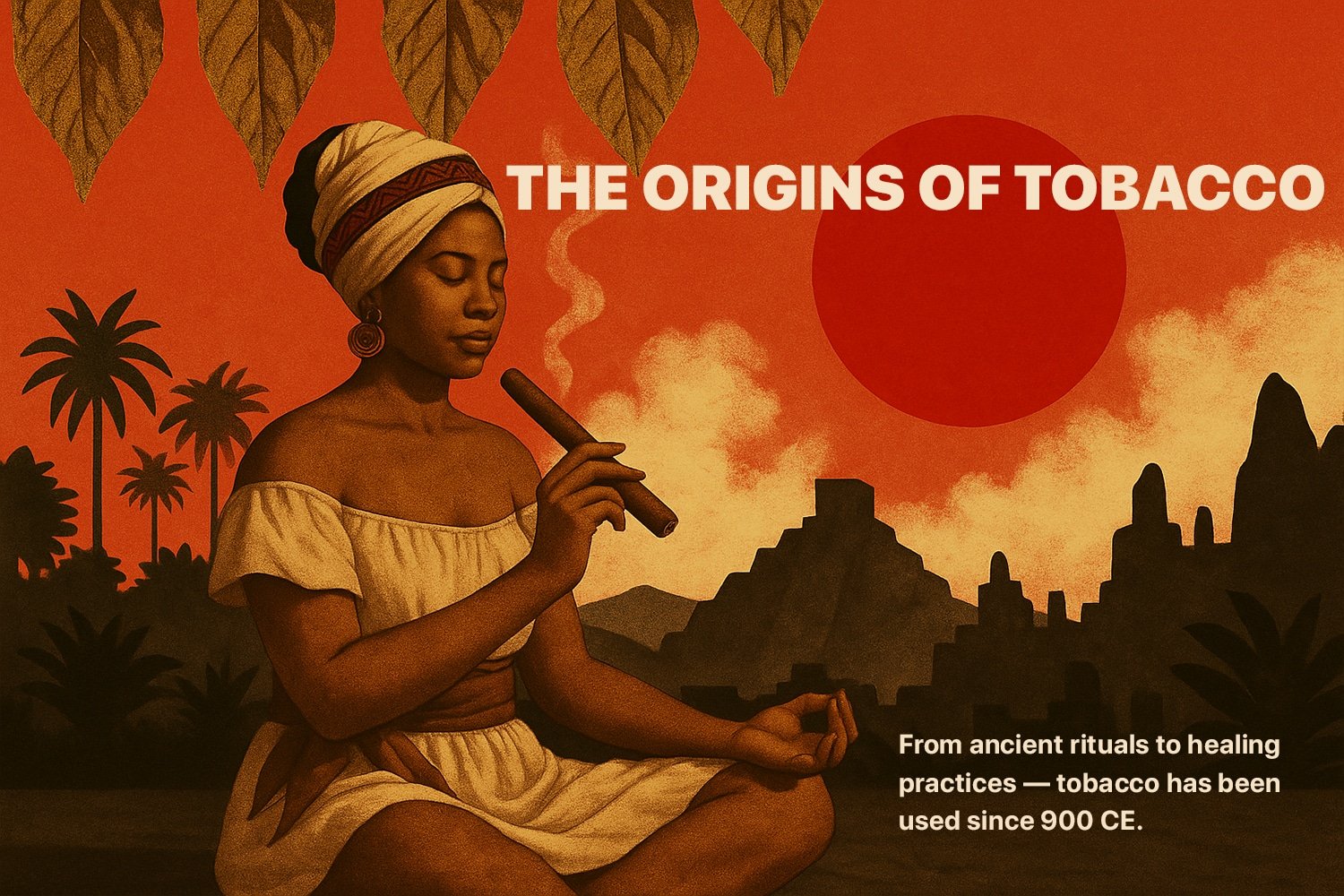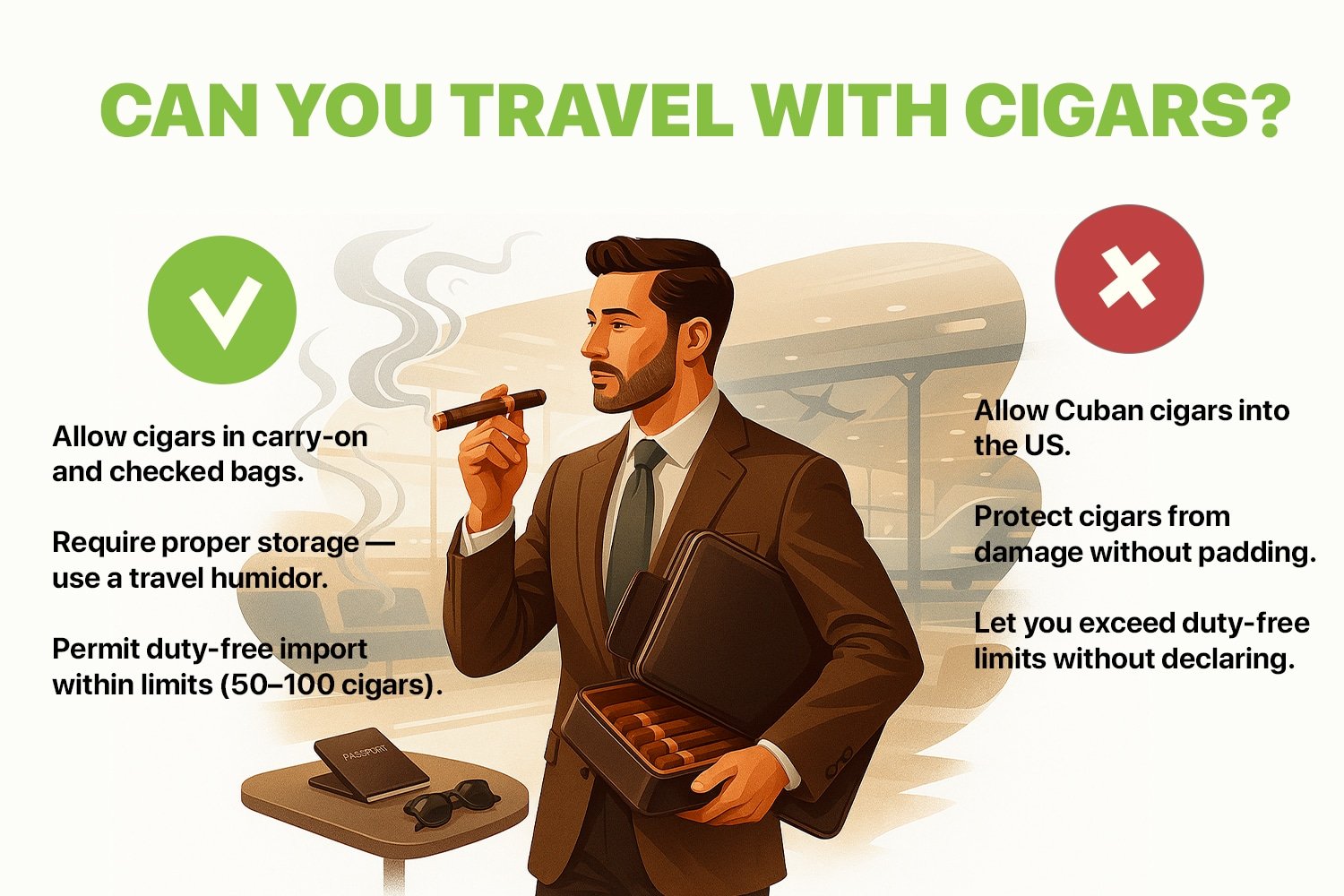Oct 31, 2025
Last Modified: Oct 31, 2025

Cigars and cigarettes are both smokable tobacco products. Featured in plenty of films and TV shows, we all know what they look like. While cigars are chunky, cigarettes are slender.
So, is a cigar basically just a bigger version of a cigarette? Far from it. Cigars and cigarettes differ in many other respects. That includes composition, cost, flavor, and environmental impact and so on.
Below, we’ll look closer at the major distinguishing characteristics. That way, we can help you decide whether to go thick or thin with your choice of smoke.
What are Cigars?

Cigars are available in many different shapes and sizes. However, all cigars comprise dried and fermented tobacco leaves. Brands make cigars by rolling these leaves into smokable bundles.
A label of paper or foil will also be looped around the cigar. This label is known as the cigar band. Often, this band will be emblazoned with the cigar brand’s logo.
Cigars are sometimes referred to as ‘stogies’. They vary significantly in length, from 3.5 to 7 inches.
What are Cigarettes?

A cigarette is also a smokable tobacco product. In this instance, the shredded tobacco leaf is compacted into cylindrical form. This, in turn, is wrapped in thin paper.
Many cigarettes are also fitted with a filter. This is meant to reduce the smokers’ exposure to harmful chemicals. Whether the filter effectively fulfills this purpose is a very different question.
Cigarettes come in numerous lengths ranging from 70mm to 120mm, but 84mm is the standard. Cigarettes generally hew to a consistent diameter of around 8mm. They are colloquially dubbed ‘cigs’.
Key Differences Between Cigars vs Cigarettes
It’s wise to clue yourself up on the main differences between a cigar vs a cigarette. Here are several factors especially worth considering:
Composition
Cigarettes usually comprise finely cut tobacco leaves tightly rolled in paper. Cigarette brands often add filters, chemicals, and flavorings to these smokes as well.
Exactly which of these additives are thrown in depends on what the brand wants to achieve. The ultimate objective, though, is simply to enhance the smoking experience. Some cigarettes are especially flavorful, while others burn impressively consistently.
Cigars, on the other hand, are often 100% tobacco. Each cigar is crafted from whole tobacco leaves. These leaves are fermented and aged to bring out their distinctive flavor. So, manufacturers often decide against artificially adding extra flavoring.
How else does a cigar’s composition differ from a cigarette’s? Well, the latter will often come with a filter. Otherwise called a filter tip, this is supposed to reduce the nicotine absorbed by the smoker. In practice, this doesn’t quite work, as the smoker will simply keep going until they get their nicotine hit.
Size
Obviously, cigars tend to be larger and thicker, but there’s a bit more to it than that. While cigarettes are generally alike in size, cigars come in a broader range of sizes.
A typical cigarette will be about 85mm in length and 8mm in diameter. Of course, you can find cigarettes deviating from these dimensions. Various types of cigarettes have been introduced over the years. This has only muddied the waters when it comes to figuring out the ‘typical’ size of a cigarette.
For example, 70mm used to be the standard length of a cigarette. However, the 84mm ‘King Size’ length has since replaced it as the standard.
Here’s a rundown of various cigarette types and their usual respective sizes:
| Cigarette type | Length (mm) | Length (inches) | Diameter (mm) |
| Regular | 70 | 2.76 | 7.8-8.0 |
| King Size | 84 | 3.3 | 7.8-8.0 |
| 100s | 100 | 3.94 | 7.8-8.0 |
| 200s | 120 | 4.72 | 7.8-8.0 |
| Slim | 84-120 | 3.3-4.7 | 5.4-6.0 |
| Super-slim | 100 | 3.9 | 5.0-5.1 |
You can even get ‘micro cigs’ as thin as 4.6mm. Nonetheless, cigarette size differences remain subtle at first glance. That’s not quite the case with cigars.
It’s easy to measure a cigar’s length, but what about its diameter? This is represented by the cigar’s ‘ring gauge’, measured in 64ths of an inch. So, if a cigar’s diameter is 55 64ths of an inch, the ring gauge is 55.
A cigar’s dimensions will largely be determined by its ‘vitola’. This Spanish word collectively refers to the stick’s size and shape. (Yes, cigars vary significantly in shape, too – more on this below.)
So, how widely do cigars vary in size? This table of cigar sizes will give you a good idea:
| Cigar vitola | Length (mm) | Length (inches) | Ring gauge |
| Mini Cigarillo | 86 | 3.4 | 20 |
| Perla | 102 | 4 | 40 |
| Robusto | 122 | 4.8 | 50 |
| Campana | 140 | 5.5 | 52 |
| Corona | 142 | 5.6 | 42 |
| Carlota | 145 | 5.7 | 35 |
| Corona Grande | 155 | 6.1 | 42 |
| Toro | 155 | 6.1 | 50 |
| Churchill | 178 | 7 | 47 |
It does bear emphasis that cigar sizes are not standardized across the industry. For example, one brand’s Robusto can be several millimeters thicker than another’s. Hence, the above table can only act as a rough guide.
Shape
It’s easy to recognize cigarettes, largely due to their shape. More often than not, this is pretty uniform, with a consistent diameter. Essentially, what you’ve got here is a slender cylinder.
It’s a very different picture with cigars, as these are rolled in a much wider range of shapes. Yes, you are certainly likely to come across some more than others. One good case in point is the Parejo shape. It’s the most common cigar shape, consisting of a straight cylinder and a rounded head.
Nicotine Content
A cigarette contains 8-20 milligrams of nicotine, while a cigar can hold 100-200 milligrams.
Initially, this statistic looks jaw-dropping. It means a single cigar can contain more nicotine than an entire pack of cigarettes. Does it also make cigars more addictive than cigarettes? Not necessarily. When it comes to cigars vs cigarettes, there’s also the matter of how they are consumed.
Cigarette smokers inhale the smoke directly into their lungs, absorbing more nicotine, while cigar smokers typically hold the smoke in their mouth and exhale, resulting in less nicotine absorption.
This explains why cigarette smokers tend to become more addicted despite cigars having higher nicotine content.
Smoking Time
As cigarettes are smaller than cigars, they can also be smoked more quickly. In fact, that’s very much what they are designed for. They are about delivering a quick nicotine hit.
What cigarette smokers don’t tend to do is stop to savor the moment. It usually takes just a few minutes to smoke a cigarette, so there’s not much of a moment to savor.
It’s a very different situation with cigars. These still contain nicotine, but are smoked rather more contemplatively. In this instance, most of the smoke is brought into the mouth. There, it is held for several minutes, enabling the smoker to really taste the various notes. The burn time can potentially last anywhere from about 15 minutes to more than two hours.
As for exactly how long, there are numerous factors at play - including the cigar’s vitola. Here’s a rough picture of how several popular vitolas differ in burn time:
| Cigar vitola | Average/approximate burn time |
| Belicoso | 50 minutes |
| Churchill | 60 minutes |
| Corona | 40 minutes |
| Double Corona | 70 minutes |
| Petit Corona | 20 minutes |
| Lonsdale | 45 minutes |
| Robusto | 45 minutes |
| Toro | 55 minutes |
| Torpedo | 55 minutes |
Flavor
A premium cigar’s flavor profile is typically vast, with notes of wood, leather, and cedar. This is before any added artificial flavors are thrown into the mix.
Yes, that’s right - much of a cigar’s flavor comes from the tobacco alone. This tobacco is carefully aged and fermented before it is placed in the cigar. So, this is no ordinary tobacco. In fact, often, it’s not even just one type of tobacco.
A cigarette’s flavor, on the other hand, is much subtler. One simple reason why is that a cigarette usually contains less tobacco. Also, as mentioned earlier, a cigarette can often be equipped with a filter. This somewhat muffles the taste of the tobacco.
Cost and Accessibility
Cigars are widely perceived as luxury goods. So, you won’t be surprised to see that they often come with price tags to match. Nonetheless, you can find plenty of budget options if you are careful where you look.
A pack of 20 cigarettes will likely set you back about $7 or $8. Yes, cigarettes can look much cheaper on paper. You can find yourself paying less than a dollar per cig. However, you can also find yourself using up that pack alarmingly quickly. After all, it can take just a few minutes to smoke a cigarette. In sharp contrast, a single cigar can potentially last for hours.
Preparation
There are many steps to preparing a cigar for smoking. The first is cutting the cigar. Even just lighting the cigar requires you to toast it first.
Cigarette smoking requires less preparation. It is recommended to tap an unopened pack multiple times against a hard surface. This is to condense loose tobacco in the paper. Doing so can ensure that the cigarettes burn longer and more smoothly.
Environmental Impact
Worldwide, how many cigarettes are littered every year? Roughly 4.5 trillion. However, it makes more sense when you recall that it takes just a few minutes to consume a cigarette. Smokers can get through packs quite quickly due to nicotine dependency.
It’s worth mentioning that cigars also pose ecological risks. Like cigarettes, they can be discarded carelessly and leak toxic chemicals. However, smokers also get through cigars at a slower pace. Cigars are also more likely to be smoked in communal areas. These are places where they can easily be disposed of responsibly.
Cultural Aspect
Believe it or not, cigarette smoking used to be considered glamorous. That’s certainly how it used to be portrayed in Old Hollywood films. However, back then, the health risks of cigarette smoking were not fully understood.
These days, the dangers that cigarettes pose to health are well-documented. This isn’t just the smoker’s health, either. Passersby can inhale smoke produced by other people. That’s why cigarette smoking has been banned in many public places.
In the ‘cigar vs cigarette’ contest, the former wins major coolness points. Why? For a start, preparing and smoking a cigar requires extra care and attention. It’s much more mindful than picking up a cig. Hence, cigars are often reserved for special occasions, like birthdays and anniversaries. This tendency has lent cigars a prestigious image.
You are supposed to really take your time when smoking a cigar. Otherwise, many of its notes can too easily go undetected. This thoughtful approach explains why cigar smoking is often best done with friends. There are cigar lounges and clubs where you can meet up with fellow cigar connoisseurs. You can form lasting bonds with them by chatting to them at length about what their palates pick up.
Cigar vs Cigarette: Comparison Table
Here’s an overview of how cigars and cigarettes compare across various measures. All of the included figures are typical amounts. Some tobacco products can fall outside these typical ranges:
| Key factor | Cigar | Cigarette |
| Composition | Tobacco | Tobacco, paper, and plastic |
| Length | 86-178 millimeters | 70-120 millimeters |
| Diameter | 20-52 ring gauge | 5-8 millimeters |
| Nicotine content | 100-200 milligrams | 8-20 milligrams |
| Smoking time | 20-70 minutes | 3-6 minutes |
| Flavor | Varied | Muted |
| Cost | $10-100 | $7-8 (per pack of 20 cigs) |
Deciding Between Cigars & Cigarettes
It’s crucial to know how to compare a cigar vs a cigarette. You need to know, for example, that the latter is often longer and thicker. This has implications for the tobacco and nicotine content.
You must also heed the differences in cost. These go beyond the price tags attached to the products. Cigarettes are cheaper upfront, but also more addictive. So, they can actually prove the more expensive option in the long run.
How can you ensure you get great value for money with your cigars? For a start, be selective about where you buy them. At Swiss Cuban Cigars, we deliver premium stogies worldwide. Feel free to browse our online store to see what we’re stocking.






